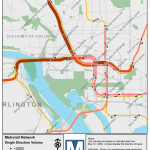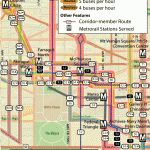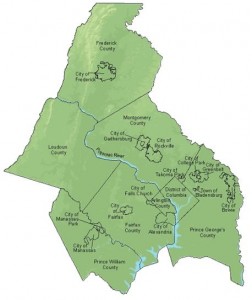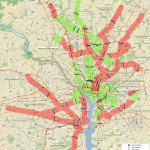
More than two-thirds of daily ridership occurs during the morning and evening peak periods. In fact, the peak ridership is a key determinant to Metro’s operating plan and future system planning efforts. An assessment of peak passenger ridership allows Metro to locate areas of current and future peak-period passenger crowding, and then plan to develop and fund capital projects aimed at addressing these capacity-constrained locations.
In 2009, Metro’s Office of Long Range Planning developed a tool to estimate passenger ridership on individual rail segments based on the station-to-station origin-destination data in the ridership database. The tool approximates passenger volume by peak hour and period. Then we use GIS to map the link-level passenger volumes.
Read more…

The Metrobus system is a robust network of surface transit lines that provide service to a variety of markets. Each different market is best served by a different type of bus service. Some bus routes only operate during the peak periods, while others operate from early morning to midnight. Some routes provide limited-stop commuter service, while others stop frequently every other block. Some routes provide only a few bus trips per hour, while others run every 10 minutes on a fixed frequency.
Metrobus lines provide a variety of services, and the current Metrobus map is designed to show all routes without regard to the service types and the markets they serve. Metro is aware that different travel markets could benefit from maps illustrating the bus service best suited to them.
Perhaps the market most in need of specialized maps and traveler information is the casual/off-peak rider. While commuters place the heaviest load on the bus system and tend to have very rigid schedules, the casual rider has no fixed schedule and travels during the off-peak times when service exceeds demand. This makes the casual rider the most inexpensive to serve, yet most difficult. The casual rider wants convenient, point-to-point travel options any time of the day without having to consult a timetable. A “12-minute” map can provide the casual rider with the information she needs to make her trip.
Read more…
 The purpose of the Regional Transit System Plan (RTSP) for 2040 is to serve as the long range transit plan including multi-modal access for the District of Columbia, Maryland, and Northern Virginia. The RTSP sets the following four project goals for the development of a comprehensive transit system plan for the region:
The purpose of the Regional Transit System Plan (RTSP) for 2040 is to serve as the long range transit plan including multi-modal access for the District of Columbia, Maryland, and Northern Virginia. The RTSP sets the following four project goals for the development of a comprehensive transit system plan for the region:
- Core Capacity – Increasing current transit capacity to the core to meet current and projected future demand and promote continued employment growth
- System Access – Improving current station access for pedestrians, cyclists, bus and automobile operators
- Surface Transit Corridors – Providing priority for surface transit corridors including express bus on HOV, rapid bus on arterials, light rail, and streetcar projects
- New and Emerging Markets – Identifying, connecting, and improving transit access to regional activity centers

Potential of Improved Running Ways to Increase Bus Ridership, Reduce Bus Operating Costs, and Increase Effective Road Capacity
Buses operating on surface streets in mixed traffic experience delay from a variety of sources, including traffic congestion, bus stops, traffic signals and passenger movements. As our region continues to grow and economic conditions make bus an ever-more appealing option for travelers of all kinds, Metrobus corridors experience more and more delay. This delay results in increased costs for bus passengers in terms of travel time, and increases the cost of providing bus service: additional buses and operators must be added to maintain desired service frequencies.
One of Metro’s proposed solutions to the increasing costs and continued degradation of bus service is the Priority Corridor Network (PCN). Metro has identified 23 high ridership corridors to receive priority treatments, which consist of both service adjustments as well as improvements to the bus (street) runningway. Service adjustments proposed include restructured routes and schedules, skip-stop operations and additional service overlays. Runningway improvements could include bus lanes, transit signal priority, queue jumpers, bus stop location, and off-board fare payment systems.
Read more…






Recent Comments